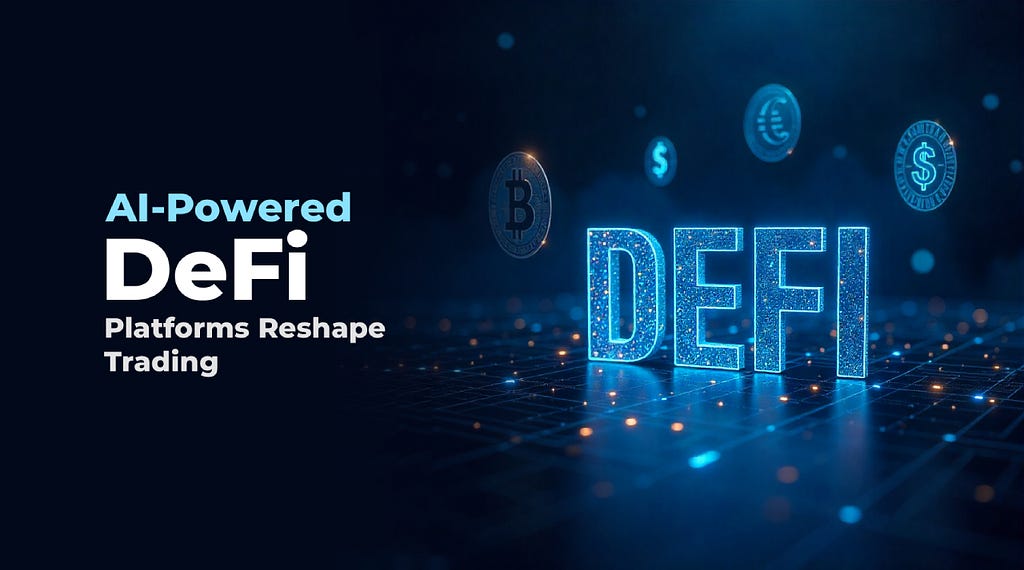How AI-Powered DeFi Platforms Reshape Trading?
 How AI-Powered DeFi Platforms Reshape Trading?
How AI-Powered DeFi Platforms Reshape Trading?The decentralized finance (DeFi) ecosystem has already transformed the way traders, investors, and institutions interact with financial systems. By removing intermediaries like banks and brokers, DeFi platforms allow users to access decentralized exchanges (DEXs), liquidity pools, lending protocols, and yield farming opportunities.
However, the rise of Artificial Intelligence (AI) in DeFi is taking this innovation to the next level. AI-powered DeFi platforms are reshaping trading by making it smarter, faster, and more secure. These platforms use machine learning (ML), predictive analytics, and automation to optimize decision-making, enhance user experience, and reduce risks in trading. In this blog, we’ll explore how AI integrates with DeFi, the benefits it brings to trading, real-world use cases, and what the future holds.
What is AI in DeFi?AI in DeFi refers to the application of artificial intelligence technologies like:
Machine learning models for price prediction
Natural Language Processing (NLP) for sentiment analysis
Automated trading bots for arbitrage
Risk management algorithms to assess lending/borrowing risks
Together, they create AI-powered DeFi platforms that improve efficiency, profitability, and user safety.
2. The Critical Influence of AI in Driving DeFi Trading InnovationAI brings multiple capabilities to DeFi platforms, especially in trading:
2.1 Predictive Market Analysis
AI algorithms analyze massive datasets — historical prices, blockchain activity, social media sentiment — to predict price movements and market trends. For traders, this means data-backed strategies instead of guesswork.
2.2 Smart Trading Bots
AI trading bots execute trades automatically based on market signals. Unlike traditional bots, AI-powered bots continuously learn and adapt to changing conditions, minimizing risks and maximizing gains.
2.3 Risk Assessment & Management
In lending and margin trading, AI models evaluate borrower creditworthiness, collateral volatility, and liquidation risks. This ensures more secure lending protocols.
2.4 Fraud Detection
AI monitors unusual activities across wallets and smart contracts, identifying scams, rug pulls, and suspicious token movements to protect traders from losses.
2.5 Automated Liquidity Management
AI optimizes liquidity allocation in pools, ensuring users receive better yields and minimizing impermanent loss for liquidity providers.
Let’s break down the advantages AI brings to DeFi traders:
3.1 Smarter Decision-Making
AI turns massive amounts of blockchain and market data into actionable insights. Traders no longer rely solely on intuition but use AI-generated signals for entry and exit points.
3.2 24/7 Trading Efficiency
DeFi markets operate non-stop, and AI bots provide round-the-clock trading, ensuring no opportunity is missed.
3.3 Lower Human Error
Human traders are prone to emotional decisions like panic-selling. AI eliminates biases by executing strategies with discipline.
3.4 Better Security
AI-powered fraud detection systems reduce risks of hacks, flash loan attacks, and rug pulls by analyzing abnormal transactions.
3.5 Personalized User Experience
AI models customize dashboards, alerts, and investment strategies tailored to each user’s goals.
Here are real-world applications of AI within DeFi platforms:
4.1 Algorithmic Trading
Crypto price trends, volume movements, and sentiment cues are analyzed by AI bots through deep learning. They adjust strategies in real time, unlike pre-programmed trading bots.
4.2 Yield Farming Optimization
AI can identify the most profitable liquidity pools across DeFi platforms, automatically shifting funds for higher returns while reducing risks.
4.3 DeFi Credit Scoring
AI helps lending protocols assess a borrower’s wallet history, transaction patterns, and collateral reliability, creating trustless credit systems without centralized credit bureaus.
4.4 Sentiment Analysis for Crypto Tokens
AI scrapes Twitter, Reddit, Telegram, and news sites to determine market sentiment around tokens. This helps traders predict pump-and-dump schemes or long-term growth potential.
4.5 Automated Arbitrage
DeFi markets often display price differences across exchanges. AI-powered bots execute arbitrage trades within seconds, profiting from inefficiencies.
4.6 Governance and DAO Management
AI assists Decentralized Autonomous Organizations (DAOs) by analyzing community proposals and suggesting data-backed decisions.
Aave + AI Risk Models
Aave, a leading DeFi lending protocol, is experimenting with AI-based risk models that assess loan defaults and volatility risks, making lending safer.
Numerai + AI Predictions
Numerai uses AI models for decentralized hedge fund trading. Traders submit predictions, and the best-performing ones help manage a crypto-based investment fund.
SingularityDAO
Built by SingularityNET, SingularityDAO combines AI with DeFi. It manages Dynamic Asset Manager (DAM) portfolios that autonomously optimize crypto trading strategies.
While promising, AI in DeFi faces hurdles:
6.1 Data Quality Issues
AI models need accurate data, but blockchain data may contain noise or manipulation (e.g., wash trading).
6.2 Computational Costs
Training AI models requires high computing power, which may not be feasible for every DeFi project.
6.3 Smart Contract Vulnerabilities
AI cannot fully protect weakly coded smart contracts from potential vulnerabilities.
6.4 Regulation & Compliance
AI-driven DeFi adds complexity for regulators, especially in KYC/AML compliance.
6.5 Centralization Risks
Relying too heavily on AI systems may introduce centralized control, contradicting DeFi’s core principles.
AI-powered DeFi platforms are just beginning, but the future looks revolutionary:
Cross-Chain AI Trading — AI models analyzing multiple blockchains simultaneously for optimized trading.
AI-Driven Robo-Advisors — Automated DeFi wealth managers providing investment strategies.
Fully Autonomous DAOs — AI managing governance and treasury with minimal human intervention.
Enhanced Security Protocols — AI detecting exploits before they happen, making DeFi safer.
Integration with Metaverse & Web3 — AI-powered DeFi platforms enabling trading in virtual economies.
8. Final ThoughtsThe combination of AI and DeFi represents one of the most exciting frontiers in fintech innovation. By merging the automation of blockchain with the intelligence of AI, these platforms are reshaping trading into a smarter, more secure, and highly profitable ecosystem.
Traders benefit from AI-powered predictions, fraud prevention, automated arbitrage, and optimized yield strategies. While challenges remain in regulation, scalability, and smart contract vulnerabilities, the momentum is undeniable.
How AI-Powered DeFi Platforms Reshape Trading? was originally published in Coinmonks on Medium, where people are continuing the conversation by highlighting and responding to this story.
